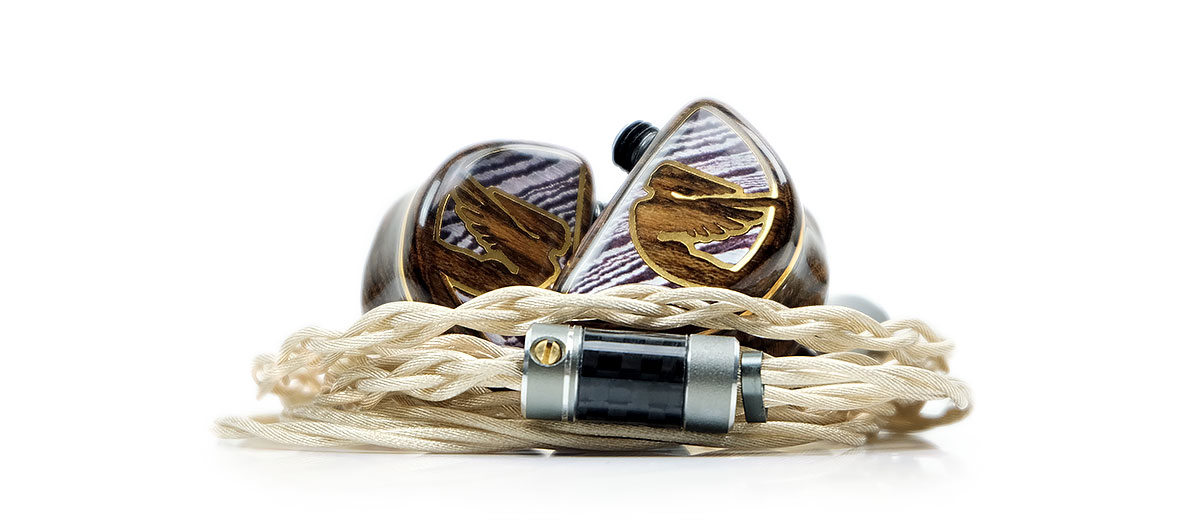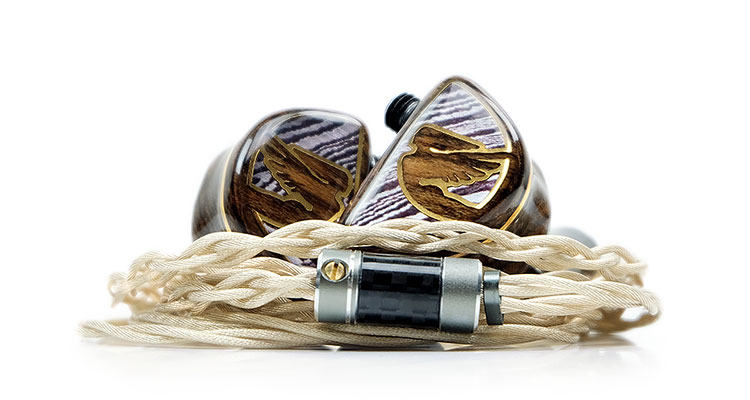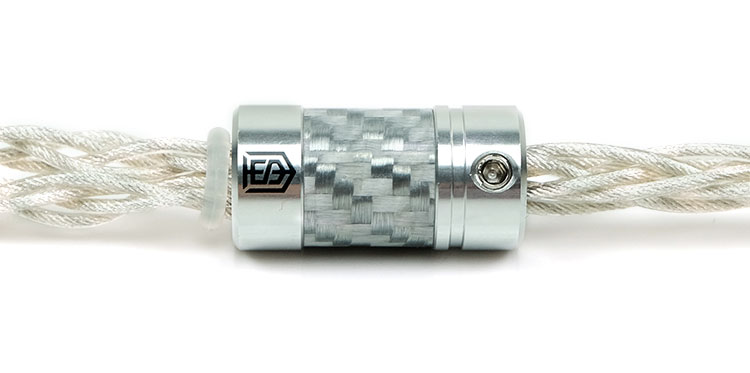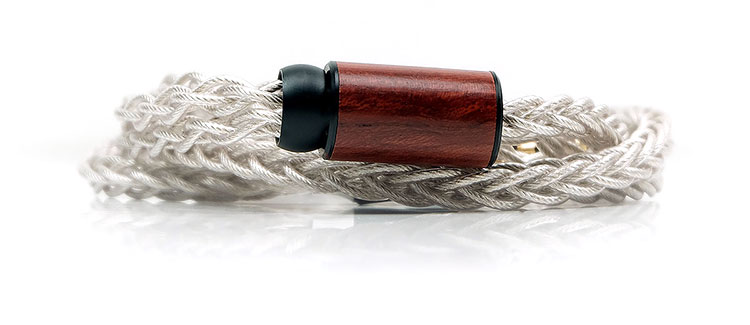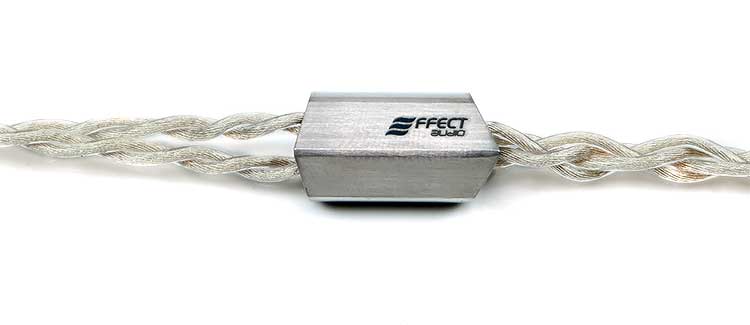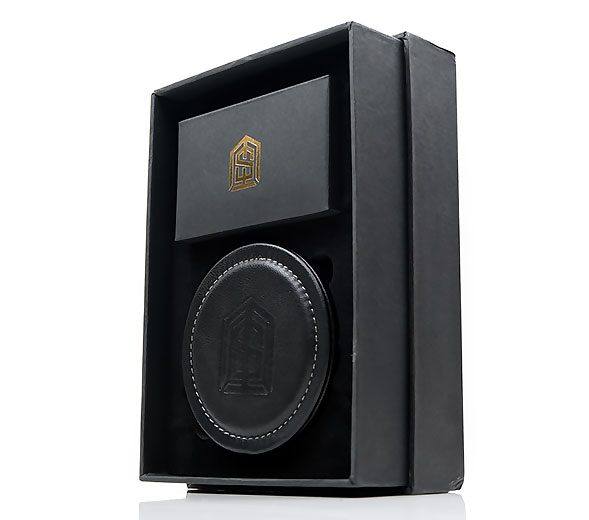Zeus Performance Impressions
Summary
The Zeus follows a similar path to EA’s Code 51 in that it produces a powerful and weighted performance, especially when combined with hybrid dynamic driver monitors. However, it does have its distinct sound and unique timbre so it is not a “Code 51 lite”.
With our tested monitors, the 64 audio tia Trio, VE’s Elysium, and the Layla from JH Audio, my perception of the Zeus pairing was almost that of a subtle bias towards a ‘quasi V-Shaped performance’, especially with the tia Trio.
That perceived bias seems to come from the way Zeus teases out a monitor’s low-end response and how much treble is allowed to shine through.
Satin Audio has gone for it with a planted bass signature from the Zeus. So much so, that I think it sounds more aggressive, yet tightly defined, than any 4-wire cable I have heard to date.
This is a strong and punchy low-end that is bloom-free and does not carry a huge amount of warmth up into the mids and treble. At the same time, the treble seems a little more energetic and forward in our tested IEMs.
I would also describe the Zeus treble as cleaner and airier sounding than their previous flagship, the Athena. Our 8-wire Athena comes off a bit soft sounding in comparison and a little flatter in its treble performance.
Mind you, a Zeus pairing does not translate to a dry and overly bright top-end from monitors. There is a hint of sweetness in its delivery from our tested IEMs that was missing from the likes of the Tri-Silver from PLUSSOUND.
Timbre
The timbral effect of a Zeus pairing is different from the likes of Athena and Code 51. There is a lot more contrast in the presentation compared to the softer Athena overtone or what I would define as a slightly more organic approach by EA’s Code 51.
The level of contrast is contextual because when I look back at my initial review of Code 51 I did say there was more contrast than something like the Leonidas II.
Well, the Zeus exaggerates that bass/treble contrast further for me which makes it seem more exciting, and more musical but also a shade thinner and cooler by comparison.
I would not describe the way the Zeus renders mids as brittle or thin per se. Again, this is a contextual description. For example, the Layla paired with Code 51 adds a bit of flesh and warmth to percussion timbre whereas the Zeus offers something a bit more pristine, lighter, or sweeter in tone.
Staging
The Zeus is incredibly deep sounding and more precise with its layering than the Athena. ‘Turn on a dime” is the expression that runs in my mind when comparing the low-end performance of Zeus compared to Athena’s voluminous but comparatively softer approach.
That tight mid-bass response of the Zeus and slightly lighter mids timbre also play well for enhanced perceived instrumental separation. For example, the Athena carries a bit more forwardness and bloom in the upper-bass and lower mids of our test monitors making it sound almost smeared.
The Zeus sounds way more complex and agile in comparison to its imaging capability. It sounds incredibly spacious and holographic and with that enhanced level of contrast, you can easily pick out individual spatial cues.
You get plenty of headroom and air with the Zeus pairing to allow the mids to breathe nice and easy.
Synergy
I felt the high impact, high contrasting tone of the Zeus to pair amazingly well with hybrid dynamic driver monitors such as 64 Audio’s tia Trio, or those monitors known for excellent musicality.
I felt the Khan was less suitable as it needs a bit more body in that piezoelectric treble to sound just right, something which Code 51 does a little bit better.
I wouldn’t necessarily pair the Zeus with a dead-neutral reference IEM. Not that it will sound bad but its low-end coloration deserves to be maximized rather than the lightish mids timbre. No need to put the breaks on an enjoyable pairing.
I did think the Zeus sounded killer on the Empire Ears Valkyrie for instance with its excellent bass response and good quality high-end e-stats performance. That type of tuning seems to really bring out the high-impact side of Zeus’s capability.
All BA monitors such as the Layla paired very well with the Zeus. The Layla deserves a better pairing than the veiled stock cable and the Zeus lifts it perfectly with some excellent upper mids and treble clarity. The additional headroom and air are immediately palpable compared to the stock pairing.
(Editorial note – We are using E4UA JH Audio Variable Bass Pod Adapters to connect the Zeus to the Layla and retain the ability to adjust the bass output levels).
Select Comparisons
All comparison work was done with a single monitor and source to ensure consistency of outcomes, in this case, 64 Audio’s Tia Trio and Lotoo’s PAW Gold Touch.
Satin Audio Athena
$799
Technical
The Athena was their previous flagship cable until the launch of the Zeus. By comparison, the pricing of the Athena is quite modest at $799 for the 8-wire version or about 40% cheaper.
Our sample is the AWG 8-wire so we will base the comparison on it despite the Zeus sample being a 4-wire.
For those worried about any loss of dynamic range going down to a 4-wire then just read the performance section for who that will not be the case. That AWG increase to 24 from 26 makes a difference.
Although, the Athena is also a palladium-plated hybrid it only uses two variants of silver, a hybrid SP-OCC palladium-plated silver mixed with SP-OCC pure silver. The Zeus ups it to three with gold-plated silver, palladium-plated silver, and a silver-gold alloy.
Both offer woven Kevlar damping at the core for additional strength and insulated strands to reduce resistance.
However, their Type 4 Litz structures are different. The Athena uses a traditional Type 4 Litz build whereas the triple blend of materials on the Zeus is designed with their new Satin Special Structures II geometry.
Design
The Zeus is smaller and easier to manage in terms of comfort and handling. However, I think both have their plus points when it comes to design and finishing.
The gold hue on the Zeus is quite attractive but it is also a little subdued compared to the fizz of the chrome and silver aesthetic of the Athena. Granted, a thicker 8-wire always comes off better for looks because there is more of it, but it is really the chrome barrel finishing that pushes it to the next level.
The use of regular gunmetal and carbon fiber feels like a step back though I do appreciate the aluminum chin cinch compared to the plastics of the Athena version. I suspect those who want their cable a little more “organic” or subtle in their finish will prefer the look of the Zeus also.
However, with that size comes bigger barrels and more weight on the Athena which for some will be a deal-breaker. The Zeus’s move to 24AWG allows them to work a smaller form factor 4-wire very efficiently to suit those who like something lighter for glasses use or more pocketable.
The addition of the Tellurium connectors and palladium-plated jacks is also a plus point for Zeus in terms of longevity and performance.
Performance
First, is the dynamic range. I do think the Athena 8-wire is marginally louder on the same pairing and source setup but the dynamic range is better on the Zeus.
The Athena can and does sound big, it has plenty of body and warmth on the low end. However, it also carries a shade more bloom and sounds slightly softer.
That means the Zeus delivers a bit more high-frequency resolution and articulation compared to the Athena. The timbre is more accurate as a result, not as liquid but the airier of the two.
You could argue it is the more “expressive” of the two cables, especially so for the upper mids and lower treble on the tia Trio where I feel the Zeus has more ‘airy energy’.
For example, I was working a finger-click passage around 3 minutes into Katy Perry’s ‘Swish Swish’ track, and with the Zeus, it was snappy, clean, and precise. With the Athena, it was smooth and liquid-like maybe fuller-sounding but also a shade flatter and less energetic.
I also found the instrumental separation on the tia Trio to be superior when paired with Zeus. The Athena has some excellent body throughout so it sounds full and at times more forward, especially vocals.
However, the slightly relaxed top-end combined with the heavier bass bloom on the Trio tends to leave a little less space for the lower-mids and vocals to breathe.
The Zeus pairing sounds tighter on the low-end, punchier also, and with less bloom into the mids from the Trio dynamic driver. You get a far better appreciation of the Trio’s bass layering and instrumental clarity as a result.
PLUSSOUND X8 Tri-Silver
$1599
Technical
The Tri-Silver was the first big 8-wire triple hybrid material cable we reviewed back at the start of 2019.
The combination of raw materials for the wiring is almost the same as the Zeus also with a mix of pure silver, palladium-plated silver, and gold-plated silver. The only difference is that the Zeus uses a silver-gold alloy wiring rather than pure silver.
The geometry and wire gauge on these are also quite different. The Zeus is a bigger 24AWG compared to the 26AWG of the Tri-Silver. However, you can get an 8-wire for the Tri-Silver whereas that option is not available yet for the Zeus.
The Tri-Silver also uses a standard Type 6 Litz geometry which features bundles of type-4 wire twisted around a fiber core compared to type 2 bundles on the Zeus Type 4 core structure.
The Zeus does seem to be the more complex application though with its insulated multi-sized stranding 2-layer approach.
Design
I have to be very fair here because PLUSSOUND makes some killer cable designs and the Tri-Silver is one of them. The braiding is so tight, the demanding effect of the PVC jacket makes it virtually noise-free and the clever use of wood in the splitter makes it remarkably light. It looks fantastic.
The Zeus does look a little subdued in comparison with the more traditional carbon fiber printed gunmetal barrels and connectors. However, what it has going for it, is the size and weight.
Despite being a larger AWG, the 4-wire build is much thinner and more manageable. Not that I think the Tri-Silver is difficult, far from it. Rather, physics is at play here and in favor of the smaller Zeus.
The weight gap is not huge, not like the Code 51 difference. The use of rosewood for the splitter on this sample helps reduce the Tri-Silver weight a lot. However, if you go for an alloy splitter on the Tri-Silver it is going to weigh a lot more.
Performance
There is just a minor difference in favor of the Tri-Silver in terms of volume which can be adjusted fairly easily to match up. Dynamic range differences are negligible between these two cables.
In terms of how they affect the timbre, the Tri-Silver is brighter, a shade drier with more emphasis on the mids and treble of the tia Trio.
The Zeus delivers more bass quantity, a sweeter timbre, and sounds the more planted of the two. You could argue that comparatively speaking Zeus is also the warmer of the two cables.
The energy on the tia Trio is thus moving in a different direction with the Zeus pushing your attention more to the low-end and the Tri-Silver emphasizing mids to upper mids and treble sparkle.
In terms of staging, the Zeus teases out a little bit more depth and mids spaciousness whereas the Tri-Silver sounds tall but also a little closer in placement on the tia Trio, particularly vocals.
Effect Audio Code 51
$2388
Technical
We just reviewed the incredible Code 51 at the run of the year and at roughly $1k more and using a similar blend of material/gauge it just had to be worth a comparison. Yup, this is also a hybrid 24AWG wire cable with gold-plated silver, silver-gold alloy, and palladium-plated silver.
The silver used, however, seems to be different. Effect Audio uses a very high-grade UP-OCC Silver in their mix whereas Satin Audio uses a high-grade SP-OCC silver wire in their geometry. As to what grade the EA version is I am not sure. However, it does mean they are most definitely not the same wire.
The geometry is both Litz though EA has not revealed exactly what Type of Litz in Code 51 other than it is a 7-core bundled design. We do know that both are multi-size stranded with individually enameled strands of wire but where they divert is the use of the Golden Ratio Principle in the 51’s geometry.
It is not impossible that Zeus’s Geometria dual layering of strands has some sort of unique pattern to each strand in the layer but they make no mention of this. I have to assume that it is not a default feature in their wire.
Handling
Both of these cables handle very well and have a similar size and aesthetic with that 24AWG wire gold hue.
They will both feel very comfortable around the ear, more so the Zeus as it lacks any sort of memory wire. Code 51 does have some memory wire so it is less comfortable but it does help dampen the physical noise beyond the splitter more than the Zeus.
Finishing
Once you get up close, however, you do start to see where Effect Audio has spent a bit more. On the Zeus, the barrels are carbon fiber and gunmetal round barrels with branded connector barrels.
Code 51 is titanium with a striking but angular titanium splitter, titanium chin cinch, and titanium jack/connector barrels. These will last you a very long time, longer than the cable possibly, and do a better job for microphonic suppression than the Zeus barrels.
However, titanium is solid and thus heavier than the Zeus barrels so you tend to feel that weight and sometimes it upsets the balance of Code 51, especially around the splitter.
I do prefer the Zeus connectors’ handling compared to the Code 51 connectors. The EA connectors aesthetically look great but they are a little smaller and harder to grip.
Braiding
The braiding is also very different. The Code 51 braiding is tighter and cleaner whereas the Zeus braiding is slightly elongated and looser in comparison. More so beyond the splitter making the 2-wire split on the Zeus a little stiffer when handling.
The Zeus jacket does feel a little softer compared to Code 51’s Ultraflexi PVC jacket. I am kind of neutral on the difference, whether it is a pro or a con I am not sure.
Certainly, the softer jacket on the Zeus helps it retain a high degree of pliancy considering it has the longest braided throw of the two cables. It could have been a lot stiffer.
Performance
First, the similarities. Both of these have a very similar level of dynamic range and with our test rig, there was no perceptive difference in volume between the two. In terms of how they both affected the presentation of the tia Trio, then there are a number of differences.
When paired with the tia Trio and Lotoo PAW Gold Touch, Code 51 sounds a little richer and more evenly balanced across the mid-range. Percussion had a bit more texture and the lower-mids also had shade more warmth and presence.
On the flip side, I found the tia Trio and Zeus pairing to be a little punchier with more quantity on the low end though slightly cooler in tone as you progressively move up the response curve.
Mids and treble sounded a shade brighter and cleaner whereas Code 51 delivers a bit more mids and vocal texture that sounds more organic or natural.
Overall, the Zeus delivers a bit more emphasis on the upper mids, treble, and bass response. It sounds comparatively high-contrast and ‘exciting’ as a result. Code 51 keeps it steady throughout and slightly less treble forwardness to get a more natural sound with more mids and percussion body.
Our Verdict
This is a really engaging, and punchy sounding cable and quite remarkable in terms of the excellent power it can deliver for a 4-wire.
I have heard 22.5AWG cables a few years back with less clarity and openness despite the thicker gauge which is a testimony to the performance cable companies can now pull from increasingly complex materials.
Importantly, Zeus has a unique performance and look when paired with the same monitors we tested with the Athena, Tri-Silver, and EA’s Code 51. I think that is important when there is a competitive overlap in the materials being used by each company.
I think this is the 5th or 6th palladium-plated infused high-end cable I have reviewed in the last 1-2 years and every single one of them has been above $1k.
This is no longer the cheap seats for Satin Audio and the potential buyer at this price point is more demanding. I still give props to Code 51 for being the most complete build and sound of the silver bunch but the Zeus is very competitive for almost half the price.
Satin Audio Zeus Specifications
- 24AWG
- Superior Pure OCC Material
- Gold Plated Silver | Palladium Plated Silver | Silver-Gold Alloy
- Geōmetria Multi-sized Stranded – Satin Special Structures II
- Kevlar Damping Core
- Premium SA Palladium Plated UCopper 2.5mm/3.5mm and Pentaconn OFC 4.4mm as standard plugs

